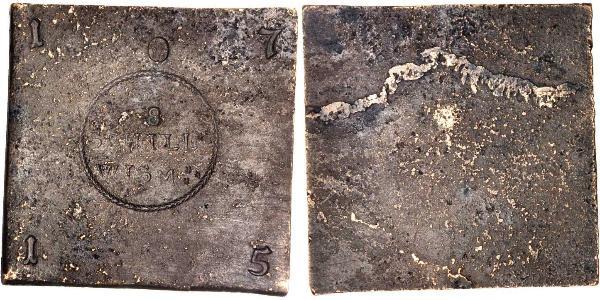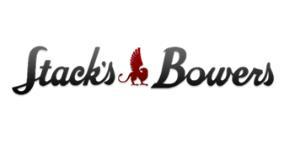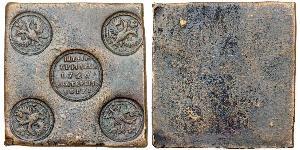(Vendue pour $17625.0)
1715,
SWEDEN. Wismar. 8 Schilling Plate Money, 1715. Karl XII (1697-1718).
EXTREMELY RARE Siege of Wismar Cannon Metal Plate Money
From The Last Swedish Stronghold in Germany
3.25 x 3.25 in. KM-119 (under Germany); BT-E; Hauer-1019. EXTREMELY RARE necessity coinage plate made from gun metal at the siege of Wismar during the Great Northern War (1700-21). Wismar was a Swedish possession along the Baltic coast of Germany, having been obtained through the Treaty of Westphalia in 1648. During the Great Northern War it was besieged by a coalition of Danish, Norwegian, Russian, Saxon, Brandenburg-Prussian and Hanoverian troops. Having withstood siege for four years the city finally fell in 1716 being the last remaining outpost of Sweden's Baltic possessions. In autumn of 1715 a severe coinage shortage presented the Swedish garrison with logistical problems, as they lacked the ability to pay troops. To resolve this a decision was made to countermark circulating silver coinage, raising their worth to twice face value. At the same time it was decided to melt down cannons for the production of plate money. The production of said plate money was found to be difficult as it could not be manufactured with the same methods as traditional plate money. Due to the hardness of the metal (similar to the Stockholm cannon money of 1714-1716), blanks could not be made by hammering the metal into sheets. Instead the molten metal had to be poured directly into sheets, hence the crude fabric of these plates. Traditionally blanks were then cut from larger sheets of metal. It is clear that the besieged Swedish forces did not have the proper machinery for sheering planchets, as the edges of these pieces show a series of file or saw marks. Therefore blanks were cut from the cast sheets with some form of saw. Rather than using dies to emboss the banks, these impression were made using single character punches to create the incuse numerals for the date, denomination and inscription. A small cartouche at the top with the letters "NW" for Necessitas Wismariensis was applied above the central circle, which is the same punch used for countermarking silver coinage during the siege. Quite distinct from other plate money of the time, the surfaces are far more rough than the pure copper plates being produced in Sweden at this time. It is reported that during the siege, 1,260 pieces of plate money were produced in six different denominations. However, upon the surrender of the Swedish garrison in April of 1716 most of these plates were collected and destroyed. It is estimated that approximately 60 pieces total are know from all 6 denominations. Of this denomination, only a handful of examples (8-10) are believed to be known, some of which are in museum collections. A true rarity with a remarkable provenance.
Pedigree: From the Stanley Aberdeen Collection.
voir plus
SWEDEN. Wismar. 8 Schilling Plate Money, 1715. Karl XII (1697-1718).
EXTREMELY RARE Siege of Wismar Cannon Metal Plate Money
From The Last Swedish Stronghold in Germany
3.25 x 3.25 in. KM-119 (under Germany); BT-E; Hauer-1019. EXTREMELY RARE necessity coinage plate made from gun metal at the siege of Wismar during the Great Northern War (1700-21). Wismar was a Swedish possession along the Baltic coast of Germany, having been obtained through the Treaty of Westphalia in 1648. During the Great Northern War it was besieged by a coalition of Danish, Norwegian, Russian, Saxon, Brandenburg-Prussian and Hanoverian troops. Having withstood siege for four years the city finally fell in 1716 being the last remaining outpost of Sweden's Baltic possessions. In autumn of 1715 a severe coinage shortage presented the Swedish garrison with logistical problems, as they lacked the ability to pay troops. To resolve this a decision was made to countermark circulating silver coinage, raising their worth to twice face value. At the same time it was decided to melt down cannons for the production of plate money. The production of said plate money was found to be difficult as it could not be manufactured with the same methods as traditional plate money. Due to the hardness of the metal (similar to the Stockholm cannon money of 1714-1716), blanks could not be made by hammering the metal into sheets. Instead the molten metal had to be poured directly into sheets, hence the crude fabric of these plates. Traditionally blanks were then cut from larger sheets of metal. It is clear that the besieged Swedish forces did not have the proper machinery for sheering planchets, as the edges of these pieces show a series of file or saw marks. Therefore blanks were cut from the cast sheets with some form of saw. Rather than using dies to emboss the banks, these impression were made using single character punches to create the incuse numerals for the date, denomination and inscription. A small cartouche at the top with the letters "NW" for Necessitas Wismariensis was applied above the central circle, which is the same punch used for countermarking silver coinage during the siege. Quite distinct from other plate money of the time, the surfaces are far more rough than the pure copper plates being produced in Sweden at this time. It is reported that during the siege, 1,260 pieces of plate money were produced in six different denominations. However, upon the surrender of the Swedish garrison in April of 1716 most of these plates were collected and destroyed. It is estimated that approximately 60 pieces total are know from all 6 denominations. Of this denomination, only a handful of examples (8-10) are believed to be known, some of which are in museum collections. A true rarity with a remarkable provenance.
Pedigree: From the Stanley Aberdeen Collection.
Prix
Similar Coin Groups
2024-04-26
- New coin is added to 2 Mark Allemagne / Hambourg Argent
2 Mark Allemagne / Hambourg Argent
Le groupe a 79 pièces / 77 prix
⇑
1914, Hamburg (Free Hanseatic City). Beautiful Silver 2 Mark Coin. PCGS MS-62!
Mint Year: 1914
Reference: KM-612.
Denomination: 2 Mark
Mint Place: Hamburg (J)
Condition: Certifi ...
2024-04-26
- New coin is added to 100 Franc Monaco Argent Rainier III
100 Franc Monaco Argent Rainier III
Le groupe a 4 pièces / 3 prix
⇑
Monaco, Rainier III, 100 francs flan bruni, 1974 Paris A/RAINIER. III. PRINCE. DE. MONACO. Tête à gauche, au-dessous signature G. SIMON et (date). R/VINGT.CINQUIEME ANNIVERSAIRE. Armes de la fami ...
Vous pourriez être intéressé par...






















